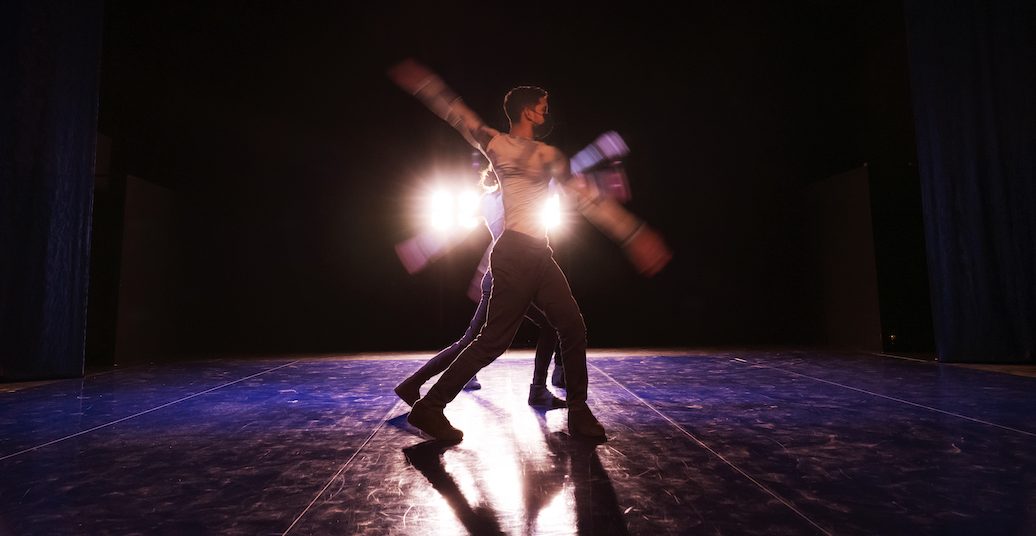Jasmin İhraç’s most recent show “liú” premiered on 15 March 2021 and was shown on HAU4 digital platform from 26 to 29 May during the Performing Arts Festival Berlin 2021. In her delicate exploration of the cycles and rhythms of nature and human life, İhraç avoids far-fetched claims and declarations and leaves the audience face to face with the miracle of the infinite time-loop. This laid-back and quiet show made me want to log these images and my thoughts, minute by minute.
19:31 — I dim the lights, turn on my PC, and put on a noise-cancelling headset. Despite being at home, I want to feel as present in the audience as I can possibly be.
19:34 — The show has started. Blue laser dots shoot through the foggy stage and reach shadowy human shapes lying on the floor. Dancers start moving back and forth. Their faces covered with masks, they crawl as if blindfolded, barely aware of each other, alone in this haunted space. I imagine that they are looking for an escape.
19:37 — A medium-sized ice block appears on stage. The dancers propel it in different directions. I enjoy the raucous sound of the ice scraping the floor, but the music renders it all but inaudible.
19:38 — It starts raining outside. I put on a sweater and turn back to the screen. Now a dancer is flying above the stage in aerial straps. The act of flying makes even their most angular movements appear delicate and elegant. I recall watching trapeze artists at the circus when I was a child. Breathless, I thought they were flying for real.
19:40 — By now the trajectory of the show is crystal-clear and it does not expect me to crack any codes to understand it. But wait, what about the title? I read the programme: ‘The Chinese sign 流 “liú” – water (氵), cloud (云), stream (川) stands for the constant floating of water and the being-in-motion of things. The stream and cycle through which everything is connected refers to processes in nature and human life.’ I turn back to the video, puzzle pieces now fitting together.
19:47 — Bright yellow lights symbolising sunlight shine into the camera. The ice block is still there, but it’s slowly melting. The stage must be slippery! The three dancers nonchalantly twirl across the stage, cutting the air with circular arm movements. I hear the whirr of cicadas embedded into the quiet electronic soundscape. I would love to see this hypnotising episode in a forest clearing, under the late-setting sun!
19:51 — Now, as the dancers slowly march in rhythm, I move closer to the screen to examine the intricate variations in the movements of their feet, and cannot take my eyes off them. The pattern evolves, their walking technique and vibrating gestures seem to defy the very notion of speed. I am unable to tell if they are moving quickly or slowly. I drink my ginger tea.
20:05 — The music has faded away into loud whispers. All of a sudden, the dancers engage in a series of animalistic solos then explode into a joyful folk-dance style routine. They jump and leap merrily to the sound of drums, their arms relaxed. I imagine them dancing outside in an evening ritual just before sunset.
20:17 — The rain outside has stopped, but now it has started raining on stage! As if preparing for nightfall, the dancers slowly lie down and in a repeat of the scene from the beginning of the show: back and forth, ebb and flow. The lights fade away. Night has fallen. A new day will begin with the dawn. The ice will glide across the floor. Humans will move the time machine forward, only to succumb once again to the threat of dusk.
20:19 — I turn off my computer and go to the kitchen to eat some fruit. Twilight is drawing in. Unlike after many other shows, my head is clear. İhraç has offered me an evening-long dive into the loop of time, where elements, time, and nature follow an infinite cyclic pattern. “liú” is free from the injunctions, agendas, and riddles around which so many dance shows heedlessly prosper. It lets me choose my own p(l)ace. I open the window to let in the scent of the evening rain. I remember the melting ice block, the only measure of time in the show, and the whirring cicadas. These images have claimed their place in my mind, and I want to keep them with me for some time. So I close my eyes.
Night — I dream of ice-covered landscapes. Immaculate glaciers dressed in radiant blue. I cruise among Saturn moons and wonder how they manage not to collide and shatter into pieces as they revolve eternally around this giant. Like the dancers in “liú”, these celestial bodies are fragile and lonely in the infinity of their forward motion. But the next morning while stirring my coffee, I notice that the seemingly infinite clockwise movement suddenly ceases and the surface of the liquid becomes still.
“liú” — Idea/Choreography/Dance: Jasmin İhraç; Choreography/Dance: David Mendez, Abel Navarro; Live-Music/Composition: RENU; Dramaturgy: Lidy Mouw; Artistic Advice: Ayşe Orhon; Light Design: Catalina Fernández; Stage: Cristina Nyffeler; Costume Advice: Franziska Sauer; Aerial Dance Movement Coaching/Rigging/Equipment: Abel Navarro; Production Management: Francesca Spisto; Camera: Smina Bluth, Silke Briel; Editing: Noam Gorbat; Sound: Janis Klinkhammer; Sound Recording and Mix: Jan Brauer.




